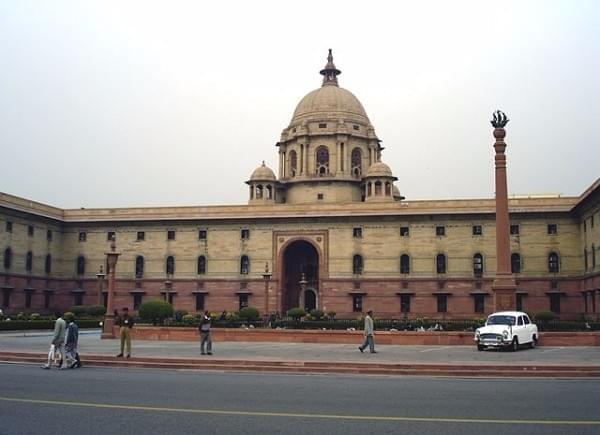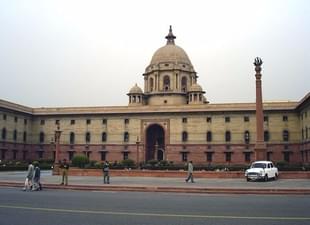Politics
Why The Lutyens Elite Makes No Sense On Its J&K Posture Anymore
Jay Bhattacharjee
Sep 15, 2016, 03:59 PM | Updated 03:58 PM IST
Save & read from anywhere!
Bookmark stories for easy access on any device or the Swarajya app.


For quite some time, this writer has been baffled by how a motley party with 45 or so members in the Lok Sabha has managed to throttle the decisions and policies of a ruling coalition of 338 members.
While adverse Rajya Sabha numbers are one answer, the real roadblock comes from the fifth column, and one is not referring to the English-language media. What is at play here is a time-tested strategy. Basically, the Indian power oligarchy has ensured a survival mechanism for its venal and egregious roots that have become enormously resilient and shock-proof. Any amateurish and half-hearted attempt to reform the country’s inherited mess is as likely to succeed as old Canute dealing with the raging sea.
To be sure, it was unrealistic to expect a system created by 60-odd years of a Nehruvian regime to lie down like a meek poodle and slink under the table after the 2014 debacle. It is a mutated Rottweiler we are dealing with.
Leaving canine metaphors aside, consider the latest salvo from the Lutyens coterie against the National Democratic Alliance (NDA) administration that has come via Singapore. Kanti Bajpai, now a Singapore resident, has a near-perfect pedigree for being a Lutyens oligarchy member. An Oxford man, he has, over a short span, done all the things that his tribe would have liked him to do. For a few years, he also presided over Doon School, an institution that trains future Lutyens coterie members. More relevantly, he belongs to a family that has effortlessly walked the corridors of power in Raisina Hill for three generations, serving the Nehru-Gandhi clan as faithfully as it did the British Raj. Before that, I am sure they would have been loyal factotums of the Mughal rulers in Delhi as well.
One notable Bajpai clan member was Kanti Bajpai’s grandfather, Sir Girija Shankar Bajpai (GSB), who was independent India’s first head of the Foreign Ministry under Nehru. Girija babu (though this appellation would have horrified the old Brown sahib) served as Agent General of India, akin to an Ambassador, in the United States (US) before independence. It has been said by many, including the veteran American diplomat and author Vincent Sheehan, in his book Nehru: The Years of Power that GSB and his team made a major blunder in drafting India’s appeal to the United Nations (UN) on Pakistan’s invasion in Kashmir.
The appeal should have been made under Chapter 7 of the UN charter rather than under Chapter 6 as was done. In the former case, the issue would have been correctly categorised as an act of aggression by Pakistan rather than as a dispute, which is what it has been treated as for all these years. This right-royal botch-up by one of Nehru’s senior-most mandarins is partly responsible for the horrendous millstone that independent India is carrying around its neck for all these decades. Admittedly, the initial fiasco was Nehru’s, since he decided to go to the UN when our armed forces had almost thrown out the Pakistani invaders. Numerous explanations have been proffered for this incredible act of folly or worse, but that is another subject.
In a quixotic way, Kanti Bajpai (KB) seems to feel that his genealogy and the historical residue bequeathed by his family member make him suitably qualified to deliver Homeric wisdom to fellow Indians on Jammu & Kashmir. There may be protests from the Lutyens elite that this essay is an ad hominem assault on KB. In fact, one of the easiest defences of this group is this argument, although it overlooks the other side of the coin, that, in most cases, an individual’s personal attributes are inseparable from the arguments that he or she propagates.
Without much ado, we should now summarise the arguments that KB put forward in his article in The Times of India a few days ago. One is trying to be as dispassionate as possible in this exercise, though one must point out that KB’s arguments and logic are so convoluted that a simple recital of his thoughts is very difficult. So, here is KB and his wisdom.
One, New Delhi and non-Kashmiris have not kept their word to Kashmiris about the autonomy “enshrined” in Article 370 of the Constitution. There has been a steady “dilution” of this Article and it has led the Kashmiris to conclude that the Central Government is dishonest and people outside Kashmir do not care about this “very much”.
Two, “Most Valley Kashmiris are Muslims” and they “may not be ecstatic about being part of a Hindu-majority India”. Even if India has formally “declared itself to be secular”, today “India is as far from being secular as it ever has been”.
Three, the Kashmiris are “frustrated”. Their future with Pakistan would be dismal and the chances of being an independent country are bleak.
And finally, the pièce de résistance, as they say in New Delhi’s salons, though this is the second issue in KB’s sequence:
Kashmiris in the Valley have never been keen on the Indian plains and the way of life there. Given the physical beauty of the Valley and the bracing climate, who can blame them? Who can blame them also for not identifying with the squalor that is the rest of India?
This is so outlandish, bizarre, twisted and distorted that it will have to be treated separately with the importance it deserves.
The first point that we should notice is that KB seems to equate the Valley with the entire state of Jammu & Kashmir (J&K). This fundamental mistake negates the basis of KB’s analysis. What he does is to concentrate only on the Valley (KB’s capitalisation), and pretend that Jammu and Ladakh are in Jupiter or thereabouts. It is high time someone reminded KB that Valley Kashmiris constitute around 55 percent of J&K’s headcount. In terms of area, the valley is even less important, 16 percent as opposed to Jammu’s 26 percent and Ladakh’s 58 percent.
The religious composition of J&K’s population in 2011 (after the ethnic cleansing of the Hindu Pandits in the state in 1990) was as follows : Hindus 28.4 percent, Sikhs 1.87 percent, Buddhist 0.89 percent and Muslims 68.3 percent. If one were to aggregate the three Indic faiths, the percentage would be 31.1 percent. This large number of people do not figure anywhere in KB’s overview of the J&K issue. They have been conveniently brushed out from his article, as was done to the Pandits in the Lutyens discourse. Or to many people and subjects in Stalinist Russia. In one picture, you are standing on the steps of the Kremlin along with the Georgian supremo, and then, suddenly, you have been vapourised.
What KB fails to understand (or, worse, what he deliberately overlooks) is that only a small percentage of the total population of the state of J&K has been unleashing this horrendous terrorism for the last two decades. These folks, who in KB’s worldview epitomise human values, camaraderie, brotherhood and empathy, are the majority Sunnis in just five districts of the entire state.
As far as the spirit of Article 370 is concerned, the vast proportion of thinking people would argue that New Delhi and the rest of India have done much more than what was required for the Valley Kashmiris and the others in J&K. For decades, these people have been kept supplied with highly subsidised food, fuel, energy and all essential commodities. The state’s own revenue generation was and is pathetic – only Union funds have kept the place going. Industry and commerce were induced to invest in the state since the restrictive provisions of industrial licensing and anti-monopoly laws (like MRTP) were not applicable there. Summarising the entire facts about Indian aid and financing of J&K for the last 68-odd years would be a major exercise and cannot be attempted here.
The second point is the dead giveaway for KB. Kashmiris cannot be ecstatic about India because they are Muslim. I wonder if KB realises the blooper that he commits here. This abominable stand should render KB hors de combat (as these IIC/JNU types are often fond of saying, forget the pronunciation). Is the learned Singapore don (not of the Bollywood variety, I hasten to add) quite sure he wants to stick to this worldview and justify it? By extension, it would mean that the Singaporean Muslims (who constitute about 14 percent of the island’s population) would also not be happy in a multi-religious country, where 50 percent of its population are Buddhist-Taoist-Hindus, and 19 percent are Christians, despite the country having an avowedly-secular political system. It would also render Muslims in many European countries and elsewhere unfit for full citizenship in the countries where they live, since they, allegedly, are unable to be happy in a non-Muslim country.
The third point of KB is equally bizarre. Just because the Valley Kashmiris (and not the rest of the population) cannot be happy in a secular India, cannot forge a viable independent country, and, horror of horrors, would not like to jump into a sinking Pakistan, they are morally entitled to commit murder and mayhem in our country. If KB’s logic is extended to the large pockets of Indian Muslims in a number of Indian states like West Bengal, Kerala, Uttar Pradesh, Assam and Bihar, one will grasp the mind-boggling ramifications of his Kashmir prescription.
However, we must conclude with KB’s second point, which is an absolute gem in his Alice-in-Blunderland analytical framework. Valley Kashmiris cannot stand the “squalor” of the rest of India because the physical beauty of the Valley and its bracing climate do not allow them to relate to the rest of the country. If this is not straight from Kipling, or Nazi herrenvolk scriptures, nothing is. It seems that the ‘Gunga Dins’ are alive and kicking among Indians even today. This is something for the desi English media to ponder on.
Jay Bhattacharjee is a policy and corporate affairs analyst based in Delhi.




